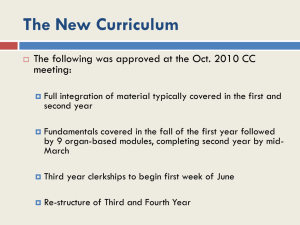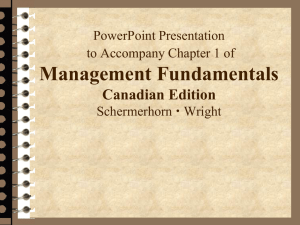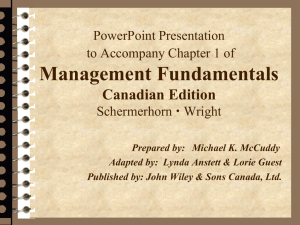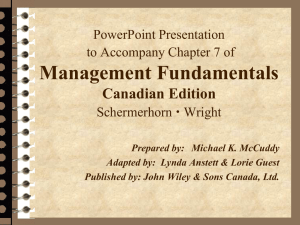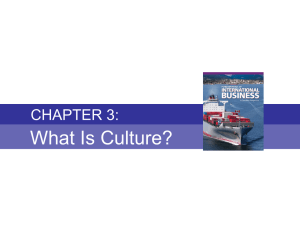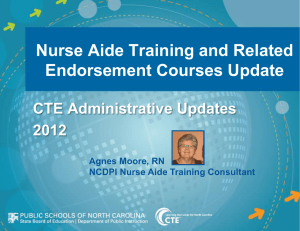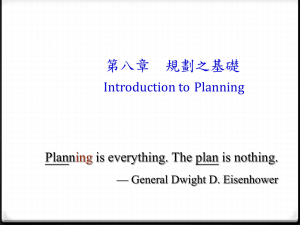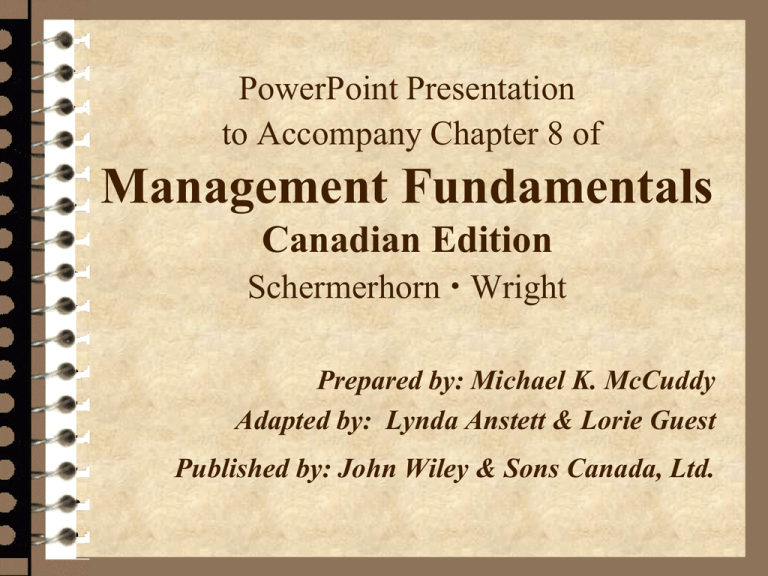
PowerPoint Presentation
to Accompany Chapter 8 of
Management Fundamentals
Canadian Edition
Schermerhorn Wright
Prepared by: Michael K. McCuddy
Adapted by: Lynda Anstett & Lorie Guest
Published by: John Wiley & Sons Canada, Ltd.
Planning Ahead — Chapter 8 Study Questions
How do managers plan?
What types of plans do managers use?
What are the useful planning tools and
techniques?
What is the control process?
What are the common organizational
controls?
Management Fundamentals - Chapter 8
2
Study Question 1: How do managers plan?
Planning
– The process of setting objectives and determining how
to best accomplish them.
Objectives
– Identify the specific results or desired outcomes that
one intends to achieve.
Plan
– A statement of action steps to be taken in order to
accomplish the objectives.
Management Fundamentals - Chapter 8
3
Study Question 1: How do managers plan?
Steps in the planning process:
– Define your objectives.
– Determine where you stand vis-à-vis objectives.
– Develop premises regarding future conditions.
– Analyze and choose among action alternatives.
– Implement the plan and evaluate results.
Management Fundamentals - Chapter 8
4
Figure 8.1 The roles of planning and
controlling in the management process.
Management Fundamentals - Chapter 8
5
Study Question 1: How do managers plan?
Benefits of planning:
– Improves focus and flexibility.
– Improves action orientation.
– Improves coordination.
– Improves time management.
– Improves control.
Management Fundamentals - Chapter 8
6
Figure 8.2 A sample means-ends chain for
total quality management.
Management Fundamentals - Chapter 8
7
Study Question 2: What types of plans do
managers use?
Short-range and long-range plans
– Short-range plans = 1 year or less
– Intermediate-range plans = 1 to 2 years
– Long-range plans = 3 or more years
People vary in their capability to deal
effectively with different time horizons.
Higher management levels focus on longer
time horizons.
Management Fundamentals - Chapter 8
8
Study Question 2: What types of plans do
managers use?
Strategic and operational plans
– Strategic plans — set broad, comprehensive, and
longer-term action directions for the entire
organization.
– Operational plans — define what needs to be done in
specific areas to implement strategic plans.
•
•
•
•
•
Production plans
Financial plans
Facilities plans
Marketing plans
Human resource plans
Management Fundamentals - Chapter 8
9
Study Question 2: What types of plans do
managers use?
Policies and procedures
– Standing plans
• Policies and procedures that are designed for
repeated use.
– Policy
• Broad guidelines for making decisions and taking
action in specific circumstances.
– Rules or procedures
• Plans that describe exactly what actions are to be
taken in specific situations.
Management Fundamentals - Chapter 8
10
Study Question 2: What types of plans do
managers use?
Budgets and project schedules
– Single-use plans
• Only used once to meet the needs and objectives of a well-
defined situation in a timely manner.
– Budgets
• Single-use plans that commit resources to activities, projects,
or programs.
• Fixed, flexible, and zero-based budgets.
– Projects
• One-time activities that have clear beginning and end points.
• Project management and project schedules.
Management Fundamentals - Chapter 8
11
Study Question 3: What are the useful
planning tools and techniques?
Forecasting
– Making assumptions about what will happen in the
future.
– Qualitative forecasting uses expert opinions.
– Quantitative forecasting uses mathematical and
statistical analysis.
– All forecasts rely on human judgment.
– Planning involves deciding on how to deal with the
implications of a forecast.
Management Fundamentals - Chapter 8
12
Study Question 3: What are the useful
planning tools and techniques?
Contingency planning
– Identifying alternative courses of action that
can be implemented to meet the needs of
changing circumstances.
– Contingency plans anticipate changing
conditions.
– Contingency plans contain trigger points.
Management Fundamentals - Chapter 8
13
Study Question 3: What are the useful
planning tools and techniques?
Scenario planning
– A long-term version of contingency planning.
– Identifying alternative future scenarios.
– Plans made for each future scenario.
– Increases organization’s flexibility and
preparation for future shocks.
Management Fundamentals - Chapter 8
14
Study Question 3: What are the useful
planning tools and techniques?
Benchmarking
– Use of external comparisons to better evaluate
current performance and identify possible
actions for the future.
– Adopting best practices of other organizations
that achieve superior performance.
Management Fundamentals - Chapter 8
15
Study Question 3: What are the useful
planning tools and techniques?
Use of staff planners
– Coordinating the planning function for the total
organization or one of its major components.
– Possible communication gaps between staff
planners and line management.
Management Fundamentals - Chapter 8
16
Study Question 3: What are the useful
planning tools and techniques?
Participation and involvement
– Participatory planning requires that the planning
process include people who will be affected by the
plans and/or will help implement them.
– Benefits of participation and involvement:
• Promotes creativity in planning.
• Increases available information.
• Fosters understanding, acceptance, and commitment to the
final plan.
Management Fundamentals - Chapter 8
17
Figure 8.3 How participation and
involvement help build commitments to plans.
Management Fundamentals - Chapter 8
18
Study Question 4: What is the
control process?
Controlling
– The process of measuring performance and taking
action to ensure desired results.
– Has a positive and necessary role in the management
process.
– Ensures that the right things happen, in the right way, at
the right time.
– Organizational learning and after-action review.
Management Fundamentals - Chapter 8
19
Study Question 4: What is the
control process?
Steps in the control process:
– Step 1 — establish objectives and standards.
– Step 2 — measure actual performance.
– Step 3 — compare results with objectives and
standards.
– Step 4 — take corrective action as needed.
Management Fundamentals - Chapter 8
20
Figure 8.4 Four steps in the control
process.
Management Fundamentals - Chapter 8
21
Study Question 4: What is the
control process?
Step 1 — establishing objectives and
standards
– Output standards
• Measure performance results in terms of quantity,
quality, cost, or time.
– Input standards
• Measure effort in terms of amount of work
expended in task performance.
Management Fundamentals - Chapter 8
22
Study Question 4: What is the
control process?
Step 2 — measuring actual performance
– Goal is accurate measurement of actual
performance results and/or performance efforts.
– Must identify significant differences between
actual results and original plan.
– Effective control requires measurement.
Management Fundamentals - Chapter 8
23
Study Question 4: What is the
control process?
Step 3 — comparing results with objectives
and standards
– Need for action reflects the difference between
desired performance and actual performance
– Comparison methods:
• Historical comparison
• Relative comparison
• Engineering comparison
Management Fundamentals - Chapter 8
24
Study Question 4: What is the
control process?
Step 4 — taking corrective action
– Taking action when a discrepancy exists
between desired and actual performance.
– Management by exception
• Giving attention to situations showing the greatest
need for action.
• Types of exceptions
– Problem situation
– Opportunity situation
Management Fundamentals - Chapter 8
25
Study Question 4: What is the
control process?
Feedforward controls …
– Employed before a work activity begins.
– Ensures that:
• Objectives are clear.
• Proper directions are established.
• Right resources are available.
– Focuses on quality of resources.
Management Fundamentals - Chapter 8
26
Study Question 4: What is the
control process?
Concurrent controls …
– Focus on what happens during work process.
– Monitor ongoing operations to make sure they
are being done according to plan.
– Can reduce waste in unacceptable finished
products or services.
Management Fundamentals - Chapter 8
27
Study Question 4: What is the
control process?
Feedback controls …
– Take place after work is completed.
– Focus on quality of end results.
– Provide useful information for improving future
operations.
Management Fundamentals - Chapter 8
28
Figure 8.5 The role of feedforward,
concurrent, and feedback controls in
organizations.
Management Fundamentals - Chapter 8
29
Study Question 4: What is the
control process?
Internal and external control
– Internal control
• Allows motivated individuals and groups to exercise
self-discipline in fulfilling job expectations.
– External control
• Occurs through personal supervision and the use of
formal administrative systems.
Management Fundamentals - Chapter 8
30
Study Question 5: What are the common
organizational controls?
Management by Objectives (MBO)
– A structured process of regular communication.
– Supervisor/team leader and workers jointly set
performance objectives.
– Supervisor/team leader and workers jointly
review results.
Management Fundamentals - Chapter 8
31
Figure 8.6 Management by objectives as
an integrated planning and control framework.
Management Fundamentals - Chapter 8
32
Study Question 5: What are the common
organizational controls?
MBO involves a formal agreement specifying …
– Workers’ performance objectives for a specific time
period.
– Plans through which performance objectives will be
accomplished.
– Standards for measuring accomplishment of
performance objectives .
– Procedures for reviewing performance results.
Management Fundamentals - Chapter 8
33
Study Question 5: What are the common
organizational controls?
The MBO process:
– Supervisor and workers jointly set objectives,
establish standards, and choose actions.
– Workers act individually to perform tasks;
supervisors act individually to provide
necessary support.
– Supervisor and workers jointly review results,
discuss implications, and renew the MBO
cycle.
Management Fundamentals - Chapter 8
34
Study Question 5: What are the common
organizational controls?
Types of MBO performance objectives
– Improvement
– Personal development
– Maintenance
Criteria for effective performance objectives
– Specific
– Time defined
– Challenging
– Measurable
Management Fundamentals - Chapter 8
35
Study Question 5: What are the common
organizational controls?
Pitfalls to avoid in using MBO
– Tying MBO to pay.
– Focusing too much attention on easily
quantifiable objectives.
– Requiring excessive paperwork.
– Having managers tell workers their objectives.
Management Fundamentals - Chapter 8
36
Study Question 5: What are the common
organizational controls?
Advantages of MBO
– Focuses workers on most important tasks and
objectives.
– Focuses supervisor’s efforts on important areas
of support.
– Contributes to relationship building.
– Gives workers a structured opportunity to
participate in decision making.
Management Fundamentals - Chapter 8
37
Study Question 5: What are the common
organizational controls?
Employee discipline systems
– Discipline is the act of influencing behavior
through reprimand.
– Discipline that is applied fairly, consistently,
and systematically provides useful control.
Management Fundamentals - Chapter 8
38
Study Question 5: What are the common
organizational controls?
To be effective, reprimands should …
– Be immediate.
– Be directed toward actions, not personality.
– Be consistently applied.
– Be informative.
– Occur in a supportive setting.
– Support realistic rules.
Management Fundamentals - Chapter 8
39
Study Question 5: What are the common
organizational controls?
Employee discipline systems
– Progressive discipline ties reprimands to the
severity and frequency of the employee’s
infractions.
– Progressive discipline seeks to achieve
compliance with the least extreme reprimand
possible.
Management Fundamentals - Chapter 8
40
Study Question 5: What are the common
organizational controls?
Important financial aspects of organizational
performance …
– Liquidity
• The ability to generate cash to pay bills.
– Leverage
• The ability to earn more in returns than the cost of debt.
– Asset management
• The ability to use resources efficiently and operate at minimum
cost.
– Profitability
• The ability to earn revenues greater than costs.
Management Fundamentals - Chapter 8
41
Study Question 5: What are the common
organizational controls?
Break-even analysis …
– Determination of the point at which sales
revenues are sufficient to cover costs.
– Break-Even Point = Fixed Costs / (Price –
Variable Costs)
– Used in evaluating:
• New products
• New program initiatives
Management Fundamentals - Chapter 8
42
Figure 8.7 Graphical approach to breakeven analysis.
Management Fundamentals - Chapter 8
43
Study Question 5: What are the common
organizational controls?
Purchasing control …
– A productivity tool
– Trends in purchasing control:
• Leveraging buying power
• Committing to a small number of suppliers
• Working together in supplier-purchaser partnerships
Management Fundamentals - Chapter 8
44
Study Question 5: What are the common
organizational controls?
Inventory control
– Goal is to ensure that inventory is just the right
size to meet performance needs, thus
minimizing the cost.
– Methods of inventory control:
• Economic order quantity
• Just-in-time scheduling
Management Fundamentals - Chapter 8
45
Study Question 5: What are the common
organizational controls?
Statistical quality control
– Quality control involves checking processes,
materials, products, and services to ensure that
they meet high standards.
– Statistical quality control involves:
• Taking samples of work.
• Measuring quality in the samples.
• Determining the acceptability of results.
Management Fundamentals - Chapter 8
46
COPYRIGHT
Copyright © 2007 John Wiley & Sons Canada, Ltd. All rights
reserved. Reproduction or translation of this work beyond that
permitted by Access Copyright (The Canadian Copyright Licensing
Agency) is unlawful. Requests for further information should be
addressed to the Permissions Department, John Wiley & Sons
Canada, Ltd. The purchaser may make back-up copies for his or her
own use only and not for distribution or resale. The author and the
publisher assume no responsibility for errors, omissions, or damages
caused by the use of these programs or from the use of the
information contained herein.


